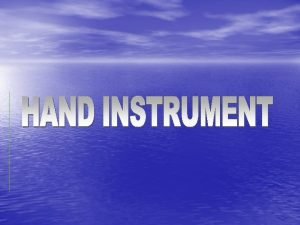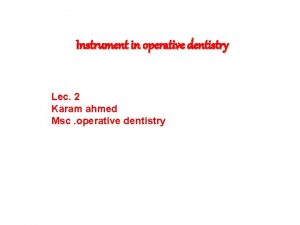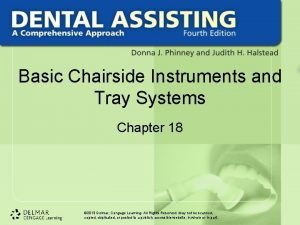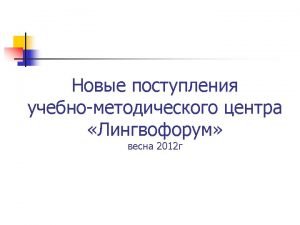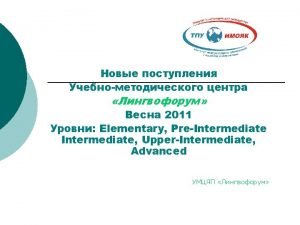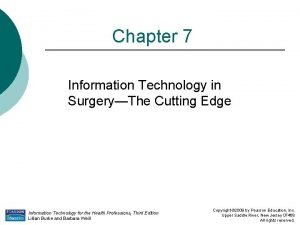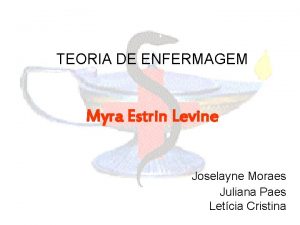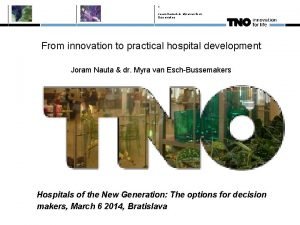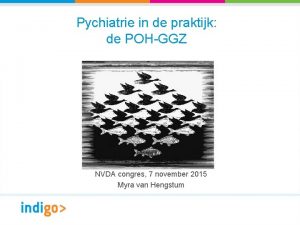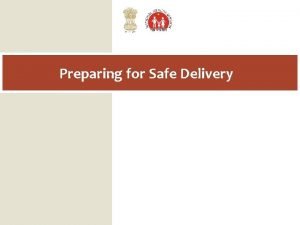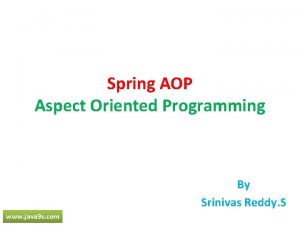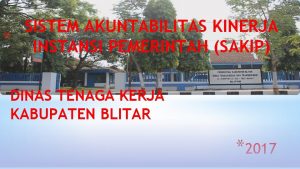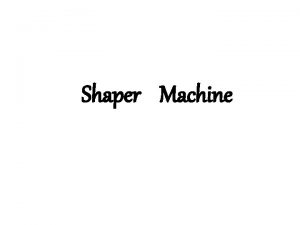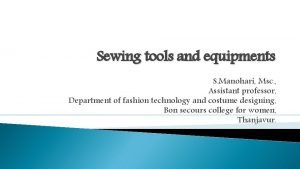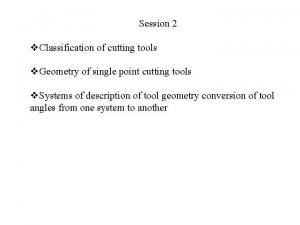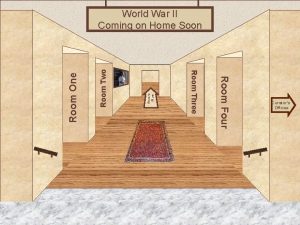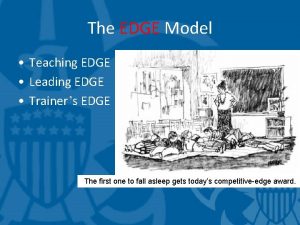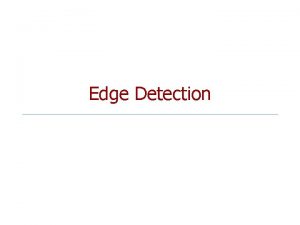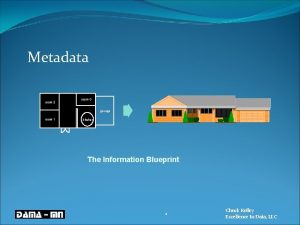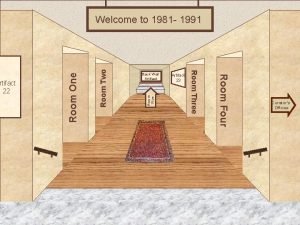Cutting Edge Delivery Room Practice Myra H Wyckoff









































- Slides: 41

Cutting Edge Delivery Room Practice Myra H. Wyckoff, MD Associate Professor of Pediatrics UT Southwestern Medical Center at Dallas

Achieving Consensus on Resuscitation Science § Since 2000, a Neonatal Task Force participates with the International Liaison Committee on Resuscitation (ILCOR) for a complete review of newborn resuscitation science every 5 years. § 26 new questions being reviewed for 2015 by the Neonatal Task Force Australian Resuscitation Council

stions and assign reviewers, and specifies minimum requirements for every search strategy, including: Medline, Embase, and Cochrane Systematic Reviews. Reviewers are also provided End. Note reference software and access to a resuscitation reference library. Every rev ILCOR Evaluation Process Brings New Resuscitation Science Forward for Review § Identify and prioritize the questions that need scientific review and assign reviewers (2 -3 per question) § Minimum requirements for every search strategy are specified and done by professional librarians – Medline, Embase, and Cochrane Systematic Reviews – Hand searches § Every reviewer rates the level and quality of evidence using a standardized evidence evaluation (GRADE system) § Consensus for each question must be reached by entire Neonatal Task Force in Feb 2015

Hot Topics for ILCOR 2015 § Should cord clamping be delayed for neonates who are non-vigorous? § How to best maintain euthermia of the neonate in the delivery room (DR)? § Does intubation and suction benefit the non-vigorous meconium stained neonate? § How should oxygen be used for premature neonates in the DR? § How to deliver initial breaths to a premature neonate in the DR? § How should heart rate be determined in the DR?

Guidelines for Neonatal Resuscitation § New “cutting edge” guidelines will be available online October 19, 2015 § Printed Guidelines supplement will be published in Circulation, Resuscitation and possibly Pediatrics § Will be able to download at: www. heart. org/cpr

2010 ILCOR Guidelines for Neonatal Resuscitation

Neonatal Resuscitation Program Guidelines § Set by the AAP NRP Steering Committee for the United States and are based on the ILCOR science review

2010 Neonatal Resuscitation Algorithm

2005 Neonatal Resuscitation Algorithm

Indications For Cardiac Compressions During Neonatal CPR: 2005 Chest Compressions are indicated when the heart rate remains below 60 bpm despite § 30 sec of providing warmth, position, suction , dry and stimulate § 30 sec of EFFECTIVE assisted ventilation

Unintended Consequences of Time Intervals in the Algorithm § Multiple reports of compressions being initiated prior to effective positive pressure ventilation or advanced airway placement – Perlman et al. ADC 1995, Finer et al. Pediatrics 1999, Wyckoff et al. Pediatrics 2010 § But if teams are trained to focus intently on inflating the lung and providing effective ventilation… – Only 1 in 1000 newborns need cardiac compressions § The time pressure of 30 seconds for initial steps, 30 seconds for PPV and then start compressions for HR<60 bpm may have contributed to these errors

2010 Neonatal Resuscitation Algorithm Extra time for assuring optimization of ventilation

Techniques for Achieving Mnemonic for remembering the six steps for improving efficacy Ventilation of positive-pressure Effective ventilation (MR. SOPA) Copyright © 2010 American Academy of Pediatrics

Poor Mask Seal Often Inhibits Effective Ventilation § 48% demonstrated significant mask leak – Majority were corrected with repositioning of the mask – Some required changing the way mask was held Schmolzer et al. ADC 2011

Inappropriate Position Often Inhibits Effective Ventilation § 25% demonstrated significant airway obstruction – Majority corrected with repositioning the infant in the open airway position Schmolzer et al. ADC 2011

Techniques for Achieving Mnemonic for remembering the six steps for improving efficacy Ventilation of positive-pressure Effective ventilation (MR. SOPA) Copyright © 2010 American Academy of Pediatrics

Indications For Cardiac Compressions During Neonatal CPR: 2010 Chest Compressions are indicated when the heart rate remains below 60 bpm despite § Providing warmth, position, suction (if needed), dry and stimulate § 30 -60 s of EFFECTIVE assisted ventilation (focus on MRSOPA steps to achieve this first including an advanced airway) Note: Because chest compressions are likely to compete with effective ventilation, rescuers are encouraged to ensure that assisted ventilation is delivered optimally BEFORE initiation of chest compressions

2010 Newborn Resuscitation Algorithm

§ § § N=189 EGA 29 wks (IQR 27 - 34) BW 1220 g (IQR 930 -2197) No delayed cord clamping Video recording of DR stabilization Time from birth to reliable signal (seconds)

Time from birth to reliable signal (seconds)

The median time taken to perform all tasks was greater than that recommended in the guidelines Number (%) of infants with recommended tasks performed by 60 seconds

The median time taken to perform all tasks was greater than that recommended in the guidelines § The recommended initial 30 - and 60 -second intervals in the algorithm may be too short § The time pressure may encourage providers to skimp on the initial steps in order to initiate PPV § Or maybe there are tasks that are just taking too long

So should we keep the 30 second intervals in the algorithm? § There will always be the need to rationally balance careful initial steps and clinical assessment in the hopes of avoiding the need for positive pressure ventilation altogether § But this will have to be balanced with the risk of additional hypoxic/ischemic injury if ventilation is not assisted in a timely enough manner

Perhaps we need to improve our methods of performing the initial steps/assessments

Heart Rate Remains The Most Important Vital Sign § § § Cardiac Output = Stroke Volume X Heart Rate Stroke Volume Does not Change Significantly in the Newborn Therefore, Heart rate determines the output to the lungs

2010 Neonatal Resuscitation Algorithm

How do you determine heart rate in the delivery room? § Palpation? § Auscultation? § Pulse Oximetry? § EKG

§ Healthy Term Deliveries (n=61) § All had HR assessed with auscultation as well as palpation of the pulse at either – Cord base – Femoral – Brachial § All auscultated heart rates were > 100 bpm Time from birth to reliable signal (seconds)

All Heart Rates were >100 bpm by Auscultation § Umbilical cord palpation was more reliable but still only 55% identified as >100 bpm, 25% <100 bpm and 20% undetectable

§ 61 nurses, mid-wives, doctors § Simulation manikin with audible heart beat § Assessed heart rate at – Birth (Scenario 1) – During initial PPV (Scenario 2) – During cardiac compressions (Scenario 3) Time from birth to reliable signal (seconds)

Providers Are Frequently Inaccurate When Auscultating Heart Rate in Manikins Time from birth to reliable signal (seconds)

Providers are Frequently Slow in Determining the Heart Rate and Inaccurate Enough to Frequently Make Decision Errors

§ ECG and Pulse Oximetry during resuscitation – Time from arrival at radiant warmer until ECG electrodes vs Pulse Ox sensor placed § VLBW infants (n=30): 26 vs 38 sec (p=0. 04) § >1500 g infants (n=16): 20 vs 26 sec (0=0. 74) – Time to achieve audible heart tones from ECG vs Pulse Ox § VLBW infants: 2 vs 24 sec ( p<0. 001) § >1500 g infants: 4 vs 32 sec (p=0. 001) § ECG provides continuous audible heart rate and may improve timeliness of critical interventions

Time from birth to reliable signal (seconds)

(In Press 2014) § N=53 babies, 755 data pairs – Median (IQR) gestational age was 37 (31 -39) wks – Delayed cord clamping § Simultaneous heart rate determinations by pulse oximetry and ECG – Time to signal Pulse Ox 99 ± 33 vs ECG 82 ± 26 sec after birth (P =. 001) Time from birth to reliable signal (seconds)

Heart Rate (BPM) In Press 2014 Blue=pulse ox Green=ECG Time from birth to reliable signal (seconds) Time after birth (s)

Heart Rate by Pulse Ox is significantly lower Press 2014 compared with ECG with clinically. Inimportant differences in the first minutes of life Blue=pulse ox Green=ECG § Unnecessary Interventions may be initiated if relying solely on Pulse to reliable Oximetry for Heart Time Rate from in thebirth delivery room signal (seconds)

Conclusions § The resuscitation algorithm becomes more science based with each iteration § The algorithm is a guideline with some suggested time intervals to balance our desire for a natural transition at birth with the need to prevent on-going asphyxial injury when transition is not going well § With our current practice, we often Do NOT meet the suggested time lines

§ Heart Rate is the most important determinant of need for interventions in the algorithm § Palpation of Heart Rate is often inaccurate § Auscultation of Heart Rate is often inaccurate and can take time away from other important resuscitation activities § ECG is much faster and more accurate in determining HR in the DR compared to pulse oximetry

In the Cutting Edge Delivery Room § Resuscitation teams that train together frequently § Have accurate tools to assess the heart rate to make appropriate decisions which allows them to… – Focus intently on proper inflation of the lung and providing effective ventilation – Document accurately in real time what they are doing to stabilize every baby – So they can reflect back on performance and look for areas of improvement

In the Cutting Edge Delivery Room § Use of ECG may increase in prominence in the cutting edge delivery room – For those babies needing resuscitation! § New technologies for rapid acquisition of ECG signal are on the horizon § There will of course be new difficulties – Cost – How to apply quickly to wet baby – Pulseless Electrical Activity
 Let's look at some examples
Let's look at some examples Marking tools in sewing
Marking tools in sewing Hand instrument formula
Hand instrument formula Palm grasp in dentistry
Palm grasp in dentistry Non cutting instruments in dentistry
Non cutting instruments in dentistry Orthogonal cutting is dimensional metal cutting
Orthogonal cutting is dimensional metal cutting New cutting edge starter
New cutting edge starter Cutting edge packaging knives
Cutting edge packaging knives Cutting edge graphics
Cutting edge graphics Teori selective influence
Teori selective influence Cutting edge peter moor
Cutting edge peter moor Flyr
Flyr Cutting edge technology
Cutting edge technology Cutting edge technology
Cutting edge technology Cutting edge
Cutting edge Cutting edge
Cutting edge Cutting workshop
Cutting workshop Cutting edge bolus
Cutting edge bolus Rising edge and falling edge
Rising edge and falling edge Cutting room flow
Cutting room flow Myra estrin
Myra estrin Myra mawby
Myra mawby Myra software
Myra software Myra van esch
Myra van esch Myra karim
Myra karim Gurney
Gurney Myra van hengstum
Myra van hengstum Bedrooms downstairs living upstairs
Bedrooms downstairs living upstairs Doris lessing to room nineteen summary
Doris lessing to room nineteen summary Hotel database sql queries
Hotel database sql queries 7 trays in labour room
7 trays in labour room Accenture delivery suite ads
Accenture delivery suite ads Practice assessor feedback examples
Practice assessor feedback examples Continuous chip
Continuous chip It is an instrument for grasping and holding
It is an instrument for grasping and holding Place
Place Cross-cutting concerns
Cross-cutting concerns What is cutting speed in milling
What is cutting speed in milling Contoh cross cutting program
Contoh cross cutting program Planer and slotter
Planer and slotter It has 4 to 5 inches finely tapered blades
It has 4 to 5 inches finely tapered blades Angle of single point cutting tool
Angle of single point cutting tool


